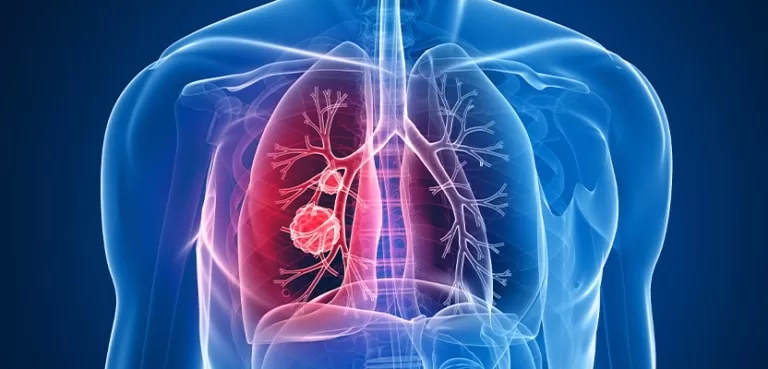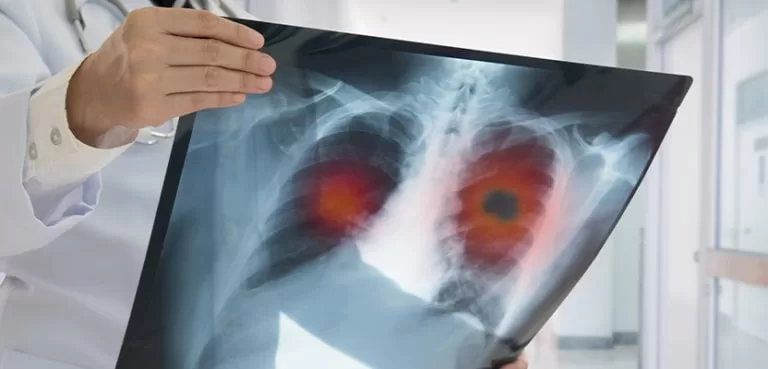+90 533 813 89 77
info@bookingforhealth.com
Lung Cancer
Lung cancer is a cancer type that starts in the lungs. It occurs when abnormal cells in the lungs grow and divide uncontrollably, forming a tumor.
These harmful cells can then spread to other parts of the body through the bloodstream or lymphatic system, a process known as metastasis. It can be classified into two main types: non-small cell lung cancer (NSCLC) and small cell lung cancer (SCLC).
NSCLC is the most common type of lung cancer, accounting for about 80-85% of all cases. SCLC is a more aggressive and fast-growing type, accounting for about 15-20% of all.

Lung Cancer: Symptoms and Causes
Like many types of it, lung cancer does not have symptoms in its early stages. The ones usually noticed by the person when the disease progresses are:
- A persistent cough that does not go away,
- Coughing up blood or rust-colored sputum,
- Chest pain or discomfort that worsens with deep breathing, coughing, or laughing,
- Shortness of breath or wheezing,
- Hoarseness or change in the voice,
- Loss of appetite or weight loss,
- Fatigue or weakness,
- Recurrent lung infections such as pneumonia or bronchitis.
The main cause is smoking. About 85% of lung cancer cases are caused by smoking cigarettes, cigars, or pipes. Exposure to secondhand smoke, radon gas, and air pollution can also increase the risk of lung cancer. Other risk factors include:
- A history of lung diseases such as chronic obstructive pulmonary disease (COPD)
- A family history of lung cancer
- Occupational exposure to certain substances such as asbestos, chromium, and nickel.
It is also essential to know that people who have never smoked can also develop lung cancer, although it is less common.
How is Lung Cancer Diagnosed?
Lung cancer can be difficult to diagnose in its early stages because symptoms often do not appear until it has grown and spread. However, there are several tests and procedures that can be used to diagnose this sick.
- Imaging Tests: Such as chest X-ray, computed tomography (CT) scan, and positron emission tomography (PET) scan can help to identify a lung tumor and determine its size and location. A CT scan, in particular, can provide detailed images of the lungs and can help to identify small tumors that may not be visible on a chest X-ray.
- Sputum Cytology: In this test, a sample of the patient’s sputum (mucus coughed up from the lungs) is examined under a microscope for the presence of cancer cells.
- Biopsy: A biopsy is a procedure in which a small sample of tissue is taken from the lung and examined under a microscope to confirm the presence of cancer. It can be done using a needle or through a surgical procedure.
- Blood Tests: They can be used to check for certain markers in the blood that can indicate the presence of lung cancer. Some examples include NSE (neuron-specific enolase) and CEA (carcinoembryonic antigen).

Lung Cancer: Treatment
Treatment for lung cancer typically involves a combination of surgery, radiation therapy, and chemotherapy. The type of treatment that is recommended will depend on the stage and type of lung cancer, as well as the patient’s overall health.
Surgery is the most common treatment for early-stage lung cancer, as with relatively all types of this illness. The goal of the operation is to remove the cancerous tumor and some of the surrounding healthy tissue. The most common types of surgery for lung cancer are lobectomy, in which a portion of the lung is removed, and pneumonectomy, in which the entire organ is removed.
The lungs have three lobes on the right side and two lobes on the left side. The lobes are the functional units of the lungs and are responsible for exchanging oxygen and carbon dioxide.
During the procedure, the surgeon makes an incision in the patient’s chest and spread the ribs to access the lung. The tumor and a small margin of healthy tissue surrounding it will be removed. The remaining lung tissue will be reattached to the airways and blood vessels.
After the surgery, the patient will be taken to a recovery room to wake up from the anesthesia. The patient will then be transferred to a hospital room for further recovery. The recovery time following a lobectomy varies from patient to patient, but it typically takes several weeks to fully recover.
Complications from lobectomy surgery may include infection, bleeding, pneumonia, and lung collapse. In some cases, complications can lead to additional surgery or prolonged hospital stay. It is important for the patient to work closely with the healthcare team to manage any complications and optimize recovery.
In addition, chemotherapy and radiotherapy options are also used in the treatment of lung cancer. Both ways can damage healthy tissues as well as cancerous cells. As they can be applied separately, there are cases where they are used together.
Immunotherapy is an innovative treatment that has been in the treatment of lung cancer in recent years. It stimulates the immune system in patients and enables them to fight cancerous cells. It is a biological treatment and can be applied to nearly 20 cancer types today.